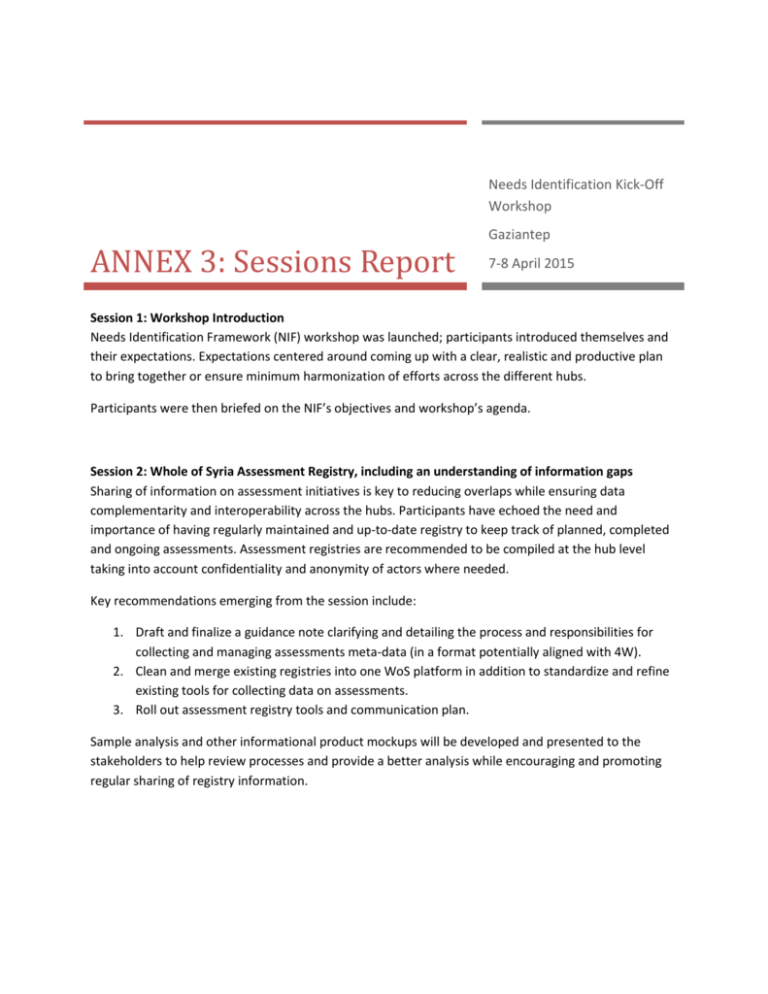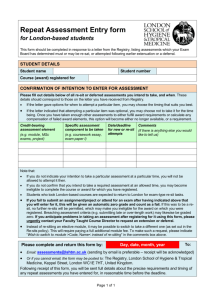annex_3_sessions_report
advertisement

Needs Identification Kick-Off Workshop ANNEX 3: Sessions Report Gaziantep 7-8 April 2015 Session 1: Workshop Introduction Needs Identification Framework (NIF) workshop was launched; participants introduced themselves and their expectations. Expectations centered around coming up with a clear, realistic and productive plan to bring together or ensure minimum harmonization of efforts across the different hubs. Participants were then briefed on the NIF’s objectives and workshop’s agenda. Session 2: Whole of Syria Assessment Registry, including an understanding of information gaps Sharing of information on assessment initiatives is key to reducing overlaps while ensuring data complementarity and interoperability across the hubs. Participants have echoed the need and importance of having regularly maintained and up-to-date registry to keep track of planned, completed and ongoing assessments. Assessment registries are recommended to be compiled at the hub level taking into account confidentiality and anonymity of actors where needed. Key recommendations emerging from the session include: 1. Draft and finalize a guidance note clarifying and detailing the process and responsibilities for collecting and managing assessments meta-data (in a format potentially aligned with 4W). 2. Clean and merge existing registries into one WoS platform in addition to standardize and refine existing tools for collecting data on assessments. 3. Roll out assessment registry tools and communication plan. Sample analysis and other informational product mockups will be developed and presented to the stakeholders to help review processes and provide a better analysis while encouraging and promoting regular sharing of registry information. Session 3: Analysis of existing data processing systems and its incorporation into the needs identification framework In an interesting session that generated discussions on complementarities and opportunities of collaboration, the following Methodologies were presented at the workshop: Area of Origin by Reach MNSA by SAMI Dynamo by ICU Governorates Profiles by OCHA HTAU by NGO forum for NGOs operating in Northern Syria Displacement Needs and Monitoring by IOM The sessions provided a common understanding of the methods in place at the different hubs. Find attached the presentations of the different methods. Session 4: Guidance and practical steps for improved displacement tracking and estimating populations in need (sector / inter-sector) As a result of group work and plenary sessions a number of recommendations were identified allowing an improved tracking and estimating populations in need: 1. There is need to undertake methodologies comparative analysis against defined criteria (e.g. geographic coverage, unit of measurement, sectors covered etc...); 2. There is need to undertake a comparative analysis between data collection/analysis tools and identify opportunities for way forward. Comprehensive comparison requires comparing the results of the different methodologies in overlapping geographic areas and timeframe; 3. There is a need to continue mainstreaming protection issues in assessments in collaboration with the protection sector; 4. There is need to strike a balance between qualitative and quantitative data when conducting analysis; 5. There is need to explore ways of strengthening AAP and feedback mechanisms are when it comes to assessments in affected communities; 6. There is need to evaluate the different standards and definitions and propose a harmonization process as a way forward; 7. There is need for a detailed WoS Cluster/Sector and multisectoral assessments and monitoring Calendar; 8. There is need for a assessments coverage mapping by method, by sub-districts by confidence in information; 9. There is need to identify areas for standard analytical processes to harmonize across methodologies (i.e. confidence levels, severity scales, prioritizations, units of analysis and stratas etc…); 10. There is need to complement the existent CODs & FODs with the missing bits and pieces; Session 5: Approaches that enable better needs and gap analysis Based on the list of “needed actions” from the previous sessions, participants have prioritized as the most urgent impactful work required to improve analysis. Participants were tasked through a group exercise to discuss one of the key priority actions and define clear objectives and sub-objectives, main activities, focal point and target dates for achieving their objectives efficiently. Group findings were presented and discussed at the end of the session and will serve as a basis in drafting strategic actions points for tackling the NIF prioritized issues. The priorities were as follows: 1. Need based response: ensure that existing initiatives feed in a unified understanding of the situation. Identify the knowledge gap and define roadmap for filling the gaps in situation awareness. 2. Registry: develop an assessment registry and map coverage of planned, completed or ongoing assessments and monitoring systems. 3. PiN and total population: Define the population, movement and PiN for better planning purpose. Concept notes per priority area will be completed and refined in the SIMAWG Sub Groups, approved and used as road maps to put these ideas to practice. Session 6: Whole of Syria data collection and analysis framework The key recommendations from the workshop were clustered together so they inform the development of the Needs Identification Framework; work that will be followed up by the SIMAWG.







